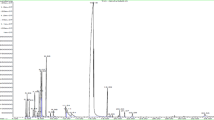Abstract
The essential oils of the leaves of Eugenia brasiliensis, Eugenia beaurepaireana, and Eugenia umbelliflora were analyzed by GC–MS. The major compounds found in the oil of E. brasiliensis were spathulenol (12.6%) and τ-cadinol (8.7%), of E. beaurepaireana were β-caryophyllene (8.0%) and bicyclogermacrene (7.2%), and of E. umbelliflora were viridiflorol (17.7%) and β-pinene (13.2%). These oils were assayed to determine their antibacterial activity against Staphylococcus aureus, Pseudomonas aeruginosa, and Escherichia coli. All of the oils analyzed showed antibacterial activity, ranging from moderate to strong, which was most accentuated for the E. umbelliflora and E. brasiliensis oils, which strongly inhibited the growth of S. aureus giving values of MIC = 119.2 and 156.2 μg/mL, respectively.
Similar content being viewed by others
References
Fischer DCH, Limberger RP, Henriques AT, Moreno PRH (2005) Essential oils from leaves of two Eugenia brasiliensis specimens from southeastern Brazil. J Essent Oil Res 17:499–500
Lee M, Nishimoto S, Yang L, Yen AY, Hatano T, Yoshida T, Okuda T (1997) Two macrocyclic hydrolisable tannin dimers from Eugenia uniflora. Phytochemistry 44:1343–1349
Hussein SAM, Hashem ANM, Seliem MA, Lindequist U, Nawwar MAM (2003) Polyoxygenated flavonoids from Eugenia edulis. Phytochemistry 64:883–889
Consolini AE, Baldini OAN, Amat AG (1999) Pharmacological basis for the empirical use of Eugenia uniflora L. (Myrtaceae) as antihypertensive. J Ethnopharmacol 66:33–39
Ogunwande IA, Olawore NO, Ekundayo O, Walker TM, Schmidt JM, Setzer WN (2005) Studies on the essential oils composition, antibacterial and cytotoxicity of Eugenia uniflora L. Int J Aromather 15:147–152
Kanazawa A, Patin A, Greene AE (2000) Efficient, highly enantioselective synthesis of selina-1,3,7(11)-trien-8-one, a major component of the essential oil of Eugenia uniflora. J Nat Prod 63:1292–1294
Timbola AK, Szpoganicz B, Branco A, Monache FD, Pizzolatti MG (2002) A new flavonol from leaves of Eugenia jambolana. Fitoterapia 73:174–176
Revilla J (2002) Plantas úteis da bacia amazônica. Inpa, Rio de Janeiro
Kuskoski EM, Vega JM, Rios JJ, Fett R, Troncoso AM, Asuero AG (2003) Characterization of anthocyanins from the fruits of baguaçu (Eugenia umbelliflora Berg). J Agric Food Chem 51:5450–5454
Machado KE, Cechinel Filho V, Tessarolo R, Mallmann C, Meyre-Silva C, Bella Cruz A (2005) Potent antibacterial activity of Eugenia umbelliflora. Pharm Biol 43:636–639
Adams RP (1995) Identification of essential oil components by gas chromatography, mass spectroscopy. Allured, Carol Stream
Murray PR (2003) Manual of clinical microbiology, 8th edn. ASM, Washington
Clinical and Laboratory Standards Institute (CLSI) (2005) Normas de desempenho para testes de sensibilidade antimicrobiana: 15° suplemento informativo. CLSI, Wayne
Oliveira RN, Dias IJM, Câmara CAG (2005) Estudo comparativo do óleo essencial de Eugenia punicifolia (HBK) DC. de diferentes localidades de Pernambuco. Rev Bras Farmacog 15:39–43
Oussalah M, Caillet S, Saucier L, Lacroix M (2007) Inhibitory effects of selected plant essential oils on the growth of four pathogenic bacteria: E. coli O157:H7, Salmonella typhimurium, Staphylococcus aureus and Listeria monocytogenes. Food Control 18:414–420
Apel MA, Sobral M, Schapoval EES, Henriques AT, Menut C, Bessiere JM (2004) Chemical composition of the essential oils of Eugenia beaurepaireana and Eugenia pyriformis: section dichotomae. J Essent Oil Res 16:191–192
Apel MA, Limberger RP, Sobral M, Henriques AT, Ntalani H, Verin P, Menut C, Bessiere JM (2002) Chemical composition of the essential oils from southern Brazilian Eugenia species. Part III. J Essent Oil Res 14:259–262
Cole RA, Haber WA, Setzer WN (2007) Chemical composition of essential oils of seven species of Eugenia from Monteverde, Costa Rica. Biochem Syst Ecol 35:877–886
Aligianis N, Kalpoutzakis E, Mitaku S, Chinou IB (2001) Composition and antimicrobial activity of the essential oil from Origanum species. J Agric Food Chem 49:4168–4170
Schwarz-Linek U, Höök M, Potts JR (2006) Fibronectin-binding proteins of Gram-positive cocci. Microbes Infect 8:2291–2298
Palombo EA, Semple SJ (2001) Antibacterial activity of traditional Australian medicinal plants. J Ethnopharmacol 77:151–157
Duffy CF, Power RF (2001) Antioxidant and antimicrobial properties of some Chinese plant extracts. Int J Antimicrob Agents 17:527–529
Kohler T, Pechere JC, Plesiat P (1999) Bacterial antibiotic efflux systems of medical importance. Cell Mol Life Sci 56:771–778
Acknowledgments
The authors are grateful to CNPq, FURB and UFSC for financial support.
Author information
Authors and Affiliations
Corresponding author
Rights and permissions
About this article
Cite this article
Magina, M.D.A., Dalmarco, E.M., Wisniewski, A. et al. Chemical composition and antibacterial activity of essential oils of Eugenia species. J Nat Med 63, 345–350 (2009). https://doi.org/10.1007/s11418-009-0329-5
Received:
Accepted:
Published:
Issue Date:
DOI: https://doi.org/10.1007/s11418-009-0329-5




